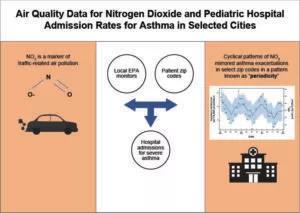Advertisement
Tracking the relationship in selected cities

Pediatric hospital admissions for asthma and bronchiolitis rise and fall with the traffic-related air pollution (TRAP) levels in cities known for their high rates of asthma, according to a new Cleveland Clinic study presented at the American Thoracic Society 2021 annual meeting. The number of pediatric asthmatic hospital admissions in Phoenix, Tucson and New York City (NYC), all designated as “asthma capitals” by the Asthma and Allergy Foundation of America, mirrored the levels of nitrogen dioxide (NO2) monitored by the Environmental Protection Agency. Many studies use NO2 levels as a surrogate marker for TRAP levels. Therefore, TRAP patterns demonstrate a clear relationship with rates of severe asthma in certain zip codes.
Advertisement
Cleveland Clinic is a non-profit academic medical center. Advertising on our site helps support our mission. We do not endorse non-Cleveland Clinic products or services. Policy
“In recent years, we’ve discovered that environmental factors play an even larger role in asthma than we previously thought,” says Neha Solanki, MD, staff in the Respiratory Institute and lead author of the study. “Though our study is preliminary, our results show a periodicity to the admission rates that mirrors the patterns of NO2 levels we see and has prompted us to continue to examine the relationship between asthma exacerbations and NO2 levels.”
Researchers examined Healthcare Cost and Utilization Project (HCUP) State Inpatient Data (SID) datasets from 2009-2011 as well as EPA data from the same period. Researchers defined pediatric admissions as emergency department and inpatient admissions of patients 17 years of age and younger with a primary diagnosis of asthma or bronchiolitis. They collected the home zip codes of these patients and then studied NO2 levels from the EPA monitors in these particular zip codes, using Loess regression to illustrate trends over 36 months. Eighty percent of patients were seen in the emergency department, and 37.3% of patients were Hispanic, 31.6% were non-Hispanic Black and 21.5% were non-Hispanic white.
“We found that in certain zip codes, the monthly rate of NO2 follows a predictable pattern of peaks and troughs (‘periodicity’) that correlates statistically with peaks and troughs of the monthly pediatric asthma hospital admission rates,” says Dr. Solanki. “Not all zip codes demonstrate this pattern. While we think that the traffic patterns and weather patterns may cause the periodicity observed, more investigation is required to elucidate this relationship.”

Asthma affected more than 300 million people in 2019 as the most prevalent chronic respiratory disease in the United States. Several studies have revealed significant associations among short-term exposures to TRAP (as measured by NO2), mortality and hospital admissions for asthma, but this is the first to track pediatric hospital admissions with EPA NO2 levels by residential zip code.
“Our study is novel because air pollution health risks vary greatly within a city, and this data by zip code is more granular and thus better reflects how risk varies by TRAP exposure levels,” says Dr. Solanki. “We now plan to examine satellite-derived data for NO2 and its effects on severe asthma and asthma exacerbations in an effort to better understand the relationship between NO2 and asthma. Our ultimate goal is to improve public health and reduce disparities and risk in pediatric populations in underserved areas.”
Advertisement
Advertisement

Specialists in the growing specialty are well-positioned to foster seamless, high-value care

Research aims to uncover the mechanisms involved in immune tolerance

Science advisory examines challenges, ethical considerations and future directions

Case highlights the benefits of a minimally invasive approach

Large registry study explores association between statin use and long-term outcomes

Multiple comorbidities are associated with pediatric psoriasis

Proof-of-concept study finds technology improves quantitative evaluation of blood flow characteristics

Panel proposes staging and treatment protocols that support harmonized evaluation and management of heart failure in patients with congenital heart disease